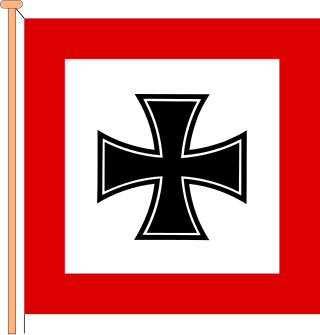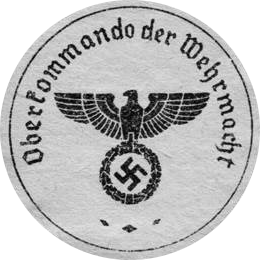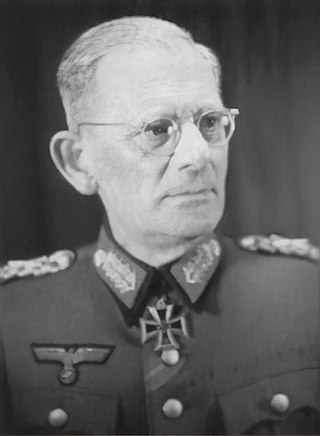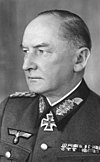
The Oberkommando des Heeres was the high command of the Army of Nazi Germany. It was founded in 1935 as part of Adolf Hitler's rearmament of Germany. OKH was de facto the most important unit within the German war planning until the defeat at Moscow in December 1941.

The Oberkommando der Wehrmacht was the supreme military command and control office of Nazi Germany during World War II. Created in 1938, the OKW replaced the Reich Ministry of War and had oversight over the individual high commands of the country's armed forces: the army, navy, and air force.

A commander-in-chief or supreme commander is the person who exercises supreme command and control over an armed force or a military branch. As a technical term, it refers to military competencies that reside in a country's executive leadership, a head of state, head of government, or other designated government official.

Maximilian Maria Joseph Karl Gabriel Lamoral Reichsfreiherr von und zu Weichs an der Glon was a German Generalfeldmarschall in the Wehrmacht of Nazi Germany during World War II.

The Supreme Commander is the highest ranked professional military officer in the Swedish Armed Forces, and is by NATO terminology the Swedish chief of defence equivalent. The Supreme Commander is the agency head of the Swedish Armed Forces and formally reports to the Government of Sweden, though normally through the Minister for Defence. The primary responsibilities and duties of the Supreme Commander are prescribed in an ordinance issued by the Government.

Military districts are formations of a state's armed forces which are responsible for a certain area of territory. They are often more responsible for administrative than operational matters, and in countries with conscript forces, often handle parts of the conscription cycle.

5th Panzer Army was the name of two different German armoured formations during World War II. The first of these was formed in 1942, during the North African campaign and surrendered to the Allies at Tunis in 1943. The army was re-formed in France in 1944, fought in Western Europe and surrendered in the Ruhr pocket in 1945.
Army Group D was a German Army Group which saw action during World War II.

The Oberkommando der Luftwaffe was the high command of the air force of Nazi Germany.

The Upper Rhine High Command, known for three days as Army Group Upper Rhine, was a short-lived headquarters unit of the German Armed Forces (Wehrmacht) created on the Western Front during World War II. The Upper Rhine High Command was formed on 26 November 1944 and deactivated on 25 January 1945. The sole commander of this headquarters unit was Heinrich Himmler.
Army Group F was a strategic command formation of the Wehrmacht during the Second World War. The commander of Army Group F served also as the Oberbefehlshaber Südost.
The Commander in Chief South was a high-ranking position in the Luftwaffe of Nazi Germany. All Luftwaffe units based in the Mediterranean and North African theatres of World War II fell under this command.
Army Group C was an army group of the German Wehrmacht during World War II. In its first deployment between 1939 and 1941, its main assignment was the defense of the Franco-German border during the Phony War and the Western Campaign, after which it was moved to East Prussia to become Army Group North. When Army Group C was recreated from 1943 to 1945, it was used to coordinate German forces on the Italian front.

The Ministry of the Reichswehr was the defence ministry of the Weimar Republic and the early Third Reich. Based in the Bendlerblock building in Berlin, it was established in October 1919 under the leadership of a defence minister and staffed mostly from the existing Prussian Ministry of War. Its longest serving Weimar era ministers were the civilian Otto Gessler and the former general Wilhelm Groener.
Philipp Kleffel was a German general during World War II who commanded several corps. He was a recipient of the Knight's Cross of the Iron Cross of Nazi Germany.

Bodo Zimmermann was a German general during the Second World War. He also was one of the few recipients of both German crosses.

The Army of the Niemen was an army level command of the German Army in World War I.

The 25th Army was a World War II field army of the German Army. It had the highest ordinal number of any of the numbered German armies.
The General Commander in the South East was the overall command of the German Armed Forces in Greece and the Balkans between 1943 and 1945 during World War II. It was directly subordinate to German Armed Forces High Command.
















